Expressing Mental Health Through Street Art
Draping black watercolours across the canvas, something distinctly human emerges from his linework. His art is cold, dark and perfectly coinciding with the heavy metal music that he has playing in the background. From the paint, a skull materialises under the guidance of a steady and experienced hand. A skull is often seen as a representation of death, mortality and horror, whilst also being a fundamental part of the human structure. The skull is a reminder that within each of us there are dark thoughts harbouring. Thomas Readett has made a name for himself by unearthing this darkness and turning it into art.
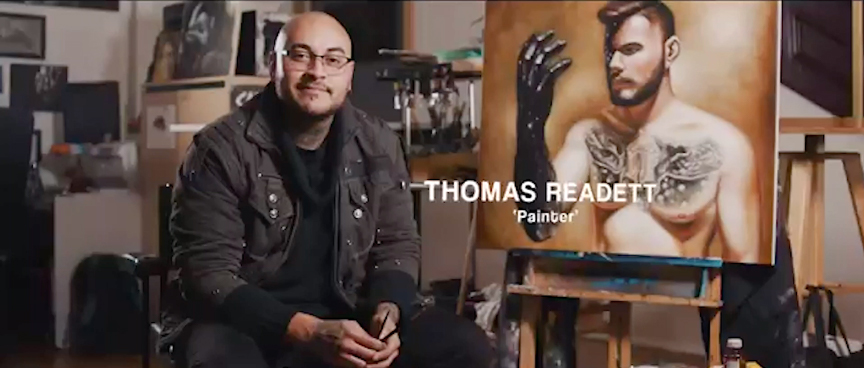
Thomas Readett, Tarnanthi Education Officer at the Art Gallery of South Australia.
Thomas Readett’s distinctive artistic style has allowed him to ascend within the South Australian art scene and take on the position of Tarnanthi, Education Officer at the Art Gallery of South Australia. Tarnanthi is an annual Festival of Contemporary Aboriginal and Torres Strait Islander Art held in the city of Adelaide. Through his work for the Tarnanthi, Readett has been able to teach and give a platform to Aboriginal and Torres Strait Islander artists from across the country.
Readett’s art has been exhibited in his solo shows: “Beneath the Skin”, “Dark Light” and “From Within”. He has also become renowned for literally leaving his mark across the city of Adelaide, by transforming multiple buildings into works of art with his large-scale mural projects. Readett has quite the list of achievements that could only seem surreal to someone who has been obsessed with drawing since childhood. The man has mastered the art of creating good circumstances out of dark, ethereal depictions.
Sitting down to interview Readett at the Art Gallery of South Australia, you can see that he emits his passion for a darker aesthetic even down to his style, with his clothing being predominately black and an impressive set of tattoos that run along his arms and neck. This aesthetic is reflective of Readett’s passion for the culture that surrounds heavy metal music, horror movies and videogames.
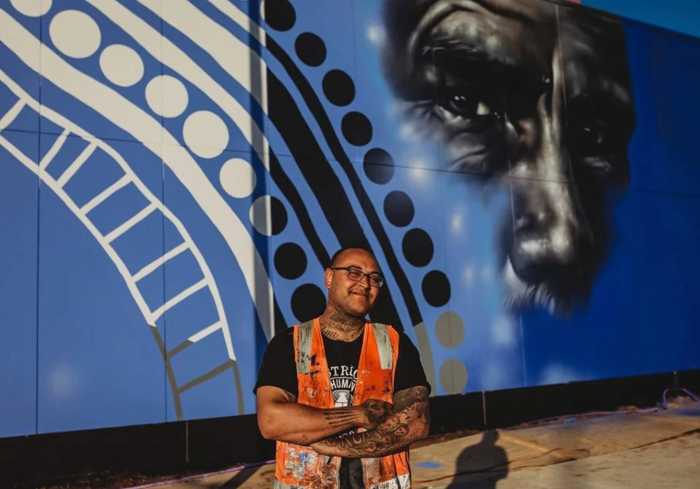
“I’ve had a darker aesthetic since I was a kid, a lot of which probably comes from being a massive fan of Tim Burton’s work,” Readett says. Readett is also inspired by artists like Caravaggio, who work with high contrasted images to bring attention to the subject. Currently, an important part of his practice is he challenging himself to paint exclusively with monochromatic colours.
“I like to see how much I can do with the essentials and see if I can make the image work before bringing in colour, which I only like to use every now and then,” he says.
When looking at Readett’s artwork, you can see that this darker aesthetic extends beyond the physical colours and into the style of art that he uses. Many of the subjects of his portraits are captured in a state of emotional turmoil, either breaking into tears or screaming. Many of his pieces are self-portraits that allude to some deeper pain within him. Due to his own struggles after losing a loved one to suicide, Readett says he is inspired to shine a light on the darker themes of mental health.
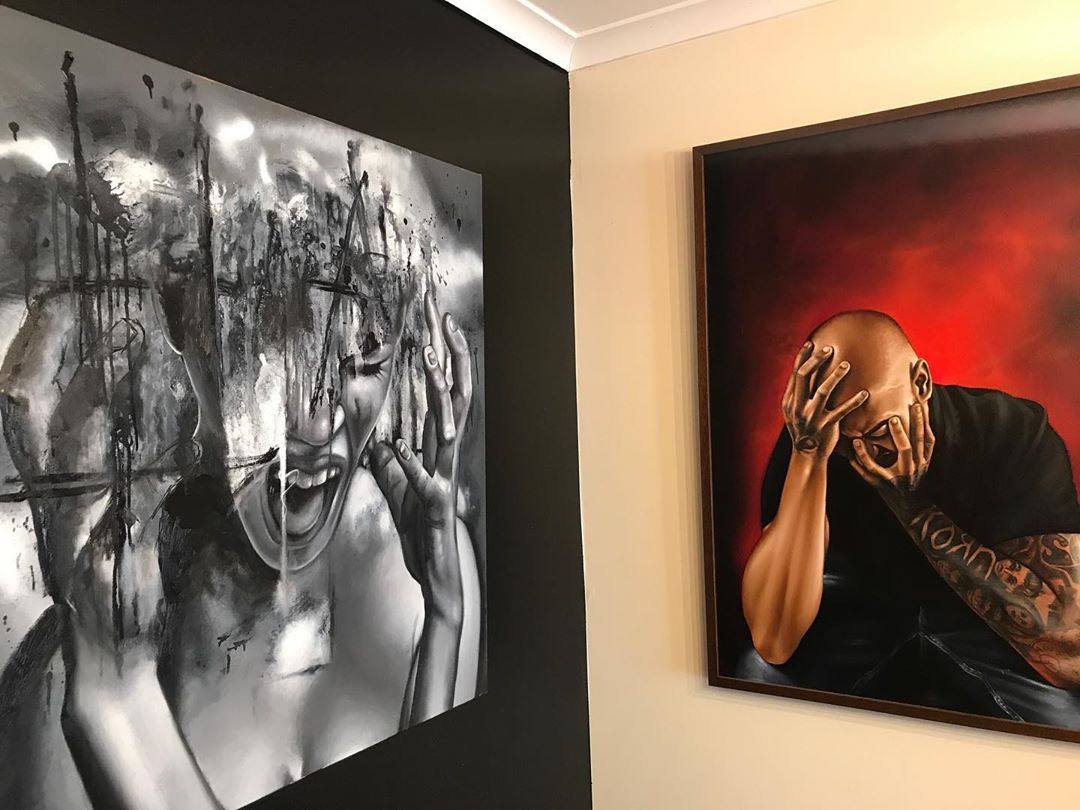
“I lost my best mate to suicide when I was 20 and, as you can imagine, anyone who has been through something like that has to learn to live with it in a certain way, otherwise it will just eat you up inside. I don’t want to carry that and other trauma around with me for my entire life, so I use art as a vehicle to express what I’m feeling.”
Statistics from lifeline Australia show that eight Australians die every day by suicide and that 75% of those who take their own lives are male. Readett says we are now finally moving into a generation where men can talk about their mental health and he sees his art as a further expression of this.
“I’m a huge advocate for talking about your mental health and putting it in the public realm as much as possible” Readett says.
He believes that if we don’t talk about tragic events caused by poor mental health they are going to keep happening. This is why Readett uses his art as a medium to help evoke the darker feelings he has had and that others have shared with him. He believes that by putting them in the public eye everyday people will know that they are not alone.
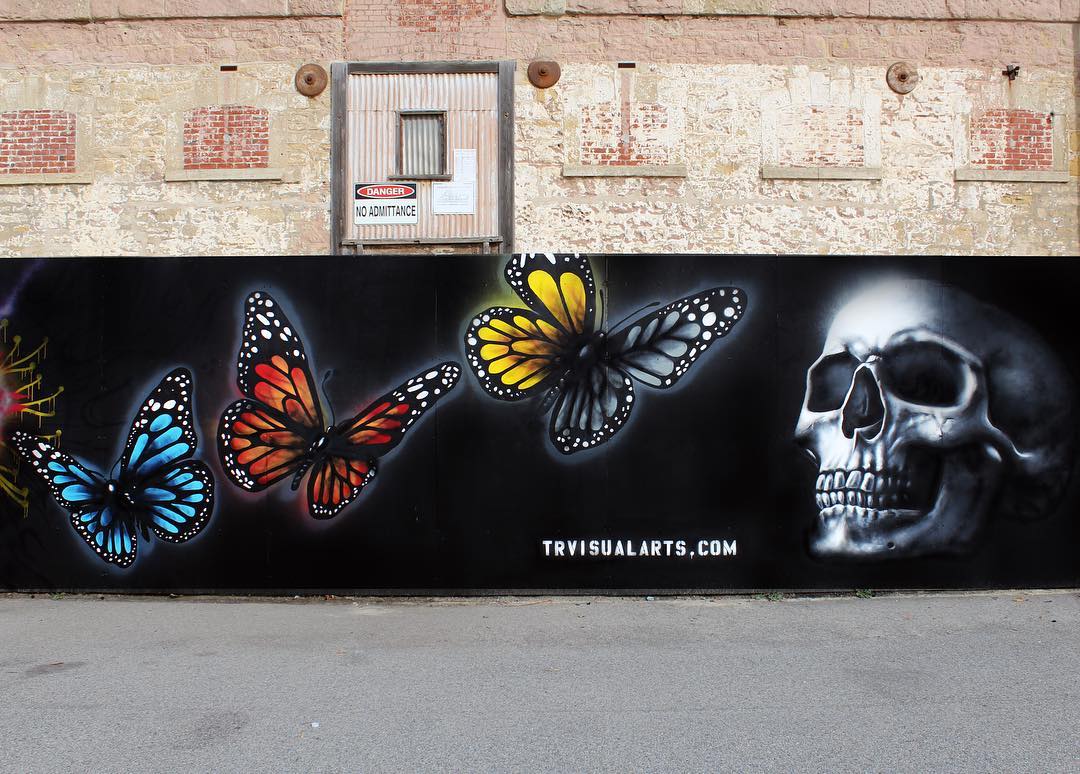
Putting this philosophy into practice, Readett worked alongside Country Health SA at Glenside Mental Health Services. The Glenside institution provides emergency and crisis services, treatment for people with mental illness, rehabilitation and recovery services for people with severe and persistent needs. By spending time with and understanding the situations of various Glenside residents, Readett aimed to express their stories of through art.
“It was heavy, but a great experience in terms of opening my eyes to different stories,” he says.
His time at Glenside was an important experience to Readett as it allowed him to get out of his own head and into another realm of meaning.
Readett believes he wouldn’t have ever understood how much people are suffering in this city if he didn’t get that residency, which he believes highlights how mental health is not being talked about enough.
“We can go home and watch the news, and stories about mental health are barely touched on. The patients are so used to not being heard, like their voices are behind a wall and we wouldn’t know about them unless you did a residency like that.”
He believes that his monochromatic art can be a way to highlight how there are so many grey areas in mental health and use it as a way to give a vital voice to those struggling.
Although touching on heavy subjects, it is easy to see that Readett has a very warm and enthusiastic attitude toward sharing his passions with the people of Adelaide. Readett is an avid participant in the annual Wonder Walls Festival and has painted a vast collection of murals throughout Adelaide. He has painted murals on a Prospect Road wall, at the Seaford Railway Station and in The Lights community and sports centre, just to name a few.
“I love the challenge of street art, due to the sheer size of the wall. You have less control compared to what you would have with a traditional canvas, so you have to adapt and take your art to new places,” Readett says.
A mural project in Prospect, Adelaide required Readett to paint a multiple-storey building. The scale of the canvas introduced Readett to new challenges he has never faced before as an artist, such as manoeuvring a scissor lift between bollard barricades and having to use the windows as measuring guides to keep the painting proportional. His street art has been widely embraced by the people of Adelaide, with Readett being commissioned for more and more murals. The support he has received only further confirms Readett’s belief that street art is growing in popularity.
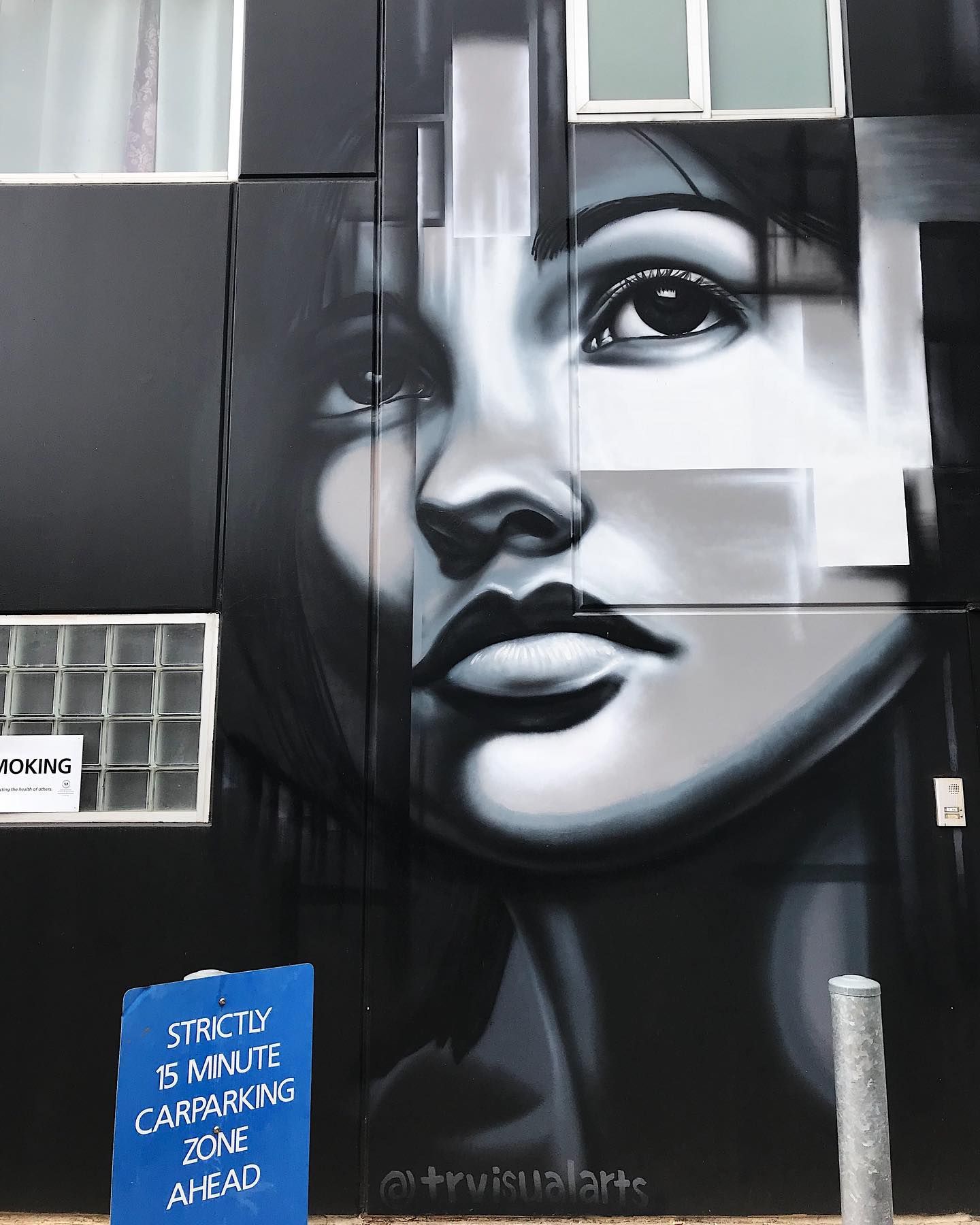
“There’s always this kind of funny definition of what is street art and what is graffiti. But it’s becoming more acceptable on the streets and that’s an art form in itself. Being able to walk into an alleyway and being knocked over by these ginormous technical portraits, I think it’s a pretty awesome thing.”
Readett encourages all artist to experiment within the street art genre. Australian cities have come to recognise street art’s role in contributing to a vibrant urban culture. With this, many city councils have established Legal graffiti walls and youth programs to allow street art to be practised responsibly.
Thomas Readett has such an effervescent and passionate personality when talking about art, so much so that it perfectly contrasts his sombre and ethereal paintings, which makes sense with his philosophy of expressing mental health problems and leaving them on the canvas to educate others. Through canvas and wall, Thomas Readett is letting the people of Adelaide know that it is ok to talk about mental health problems.
To see more of Readett’s work, visit his website.
What do you think? Leave a comment.











Thank you. Great article on a great artist. I used to be quite involved in “art scenes” but gradually, over time I come to see most of the people in this world simply as people craving attention, getting a few crumbs of recognition. They spend more time promoting themselves that actually working on their craft. I don’t have much time for self proclaimed “artists” anymore. I still make part on my free time, for mental health reasons specifically.
I think you’re right. Living in a time of social media, people have become accustomed to purely engaging in art because of the gratification they will receive from others. It’s refreshing to hear stories of people engaging in art for themselves and their own mental well being.
This is one of the many compelling reasons why the Arts should not be squeezed out of the curriculum in schools.
I agree. Many students struggle to express their feelings through traditional means. Art programs give them a medium to express themselves in a much more secure environment.
Mental health in art throughout the years has always been really fascinating.
The French have a word for art created during fits of madddddness: ‘Art Brute’. One could even pose that without inner demons no good art possible is – c’est Jacques Lacan – every bit of creation, every thought even – stems from the seeds of death, despair, and depression: Les anges noirs!
That in the sad Freudian-Anglo universe such thinking is a severe taboo for the general public is because you like to divide everyting in good and evil like simple christians, observant muslims, good jews or bad zoroastrians – so that your bourgeoisie may always safely distinguish right from wrong. All mad to the madhouse. All perverts to jail. All crimes be punished. All sick to the hospital. And so it goes ..
Good piece on a challenging theme – mental ‘illness’. I will be keeping an eye for Thomas’ work.
Art as therapy indeed and also creativity that is linked with our deep emotions.
This is a unique way to bring mental health to the public’s attention. We need more artists like Thomas in our cities.
I agree, making art like Thomas’s more common in cities can normalise ideas like being open about your mental health.
Mental health, and men’s mental health in particular, desperately requires attention and discussion. Arguably more so now than ever.
We should be championing people like Readett who are choosing to express this so common struggle in a healthy and accessible way. Great read!
These type of art speak volumes, where words alone often cannot convey the agony of mental illness. Probably quite cathartic for the artists who created these images too, I would imagine.
I totally agree with you Rose. I believe as humans we can be very inclined to repress thoughts that cause us distress. So by putting those thoughts and feelings into a physical form like art can be a very therapeutic form of facing them.
My mental health improves when I compose, write, draw, sing/play, dance, crochet, macrame, paint, sculpt……. while some of these I do more than others, it is the same idea. Sometimes it helps to vent, but mostly, the art I’m engaging in often has answers or solutions to the problem….. this is what I see in Readett’s works in this article! the problems and solutions, or resolutions in the pieces themselves.
Not to mention the impact that a visit to a museum or to an art exhibition may have on our personality is generally extensive. Remember the reaction of Stendhal on his visit to Rome beauties. The first thing I do before selecting any town visit is to ascertain if at least one archeological museum and a pinacoteche is available. This confirms that the visit will be an unforgettable event contributing to my wellness.
Museums exhibits give me chills just thinking about the last I visited. Like a palace to walk through of a main idea. How powerful, how effective.
It is striking how little the expression of mental illness in art has changed over the past 500+ years. Doesn’t say much for our oh-so-modern and sophisticated understanding of the mind and its processes/problems, does it… Mad in 1495 (inexplicable invasion of religious demons), mad in 2020 (inexplicable invasion of scientific demons.) Still so little understanding, still so far from a cure.
my number one favorite way to kill a demon: put it somewhere outside of yourself, name it, heal it
This is a wonderful read and uplifting as not enough importance and links are being made to mental health and the arts. Reading this reminded me of a story in, ‘The Man Who Mistook His Wife For A Hat’ by Oliver Sacks. It was not until Dr Sacks made a home visit to a client where he was able to gain a much greater perspective and understanding of his client’s mental health, through the art created. Art Therapy should be integral to mental health services. Just go and explore Bethlem Hospital services Museum of the Mind:
https://museumofthemind.org.uk/collections/gallery
Certainly, when working in the field of trauma, art as a means of expression may be all a child or adult is able to use as a means of self-expression. The creation of art permits a distance which enables the client to approach life events without necessarily thinking about it in the process while reducing the impact of emotional and psychosomatic pain. It is the unpicking and exploration that follows afterwards which can be powerful as well as liberating.
Yes. Art can be a powerful tool, I’ve seen it help so many people!
I have a small oil painting, a white background with a flower emerging and buds opening. This was a gift to me following an intervention with a family (mother) who had asked me to help get her children (5) taken into care. She was of the view that she had not protected them from the abuse by their father. I can’t talk about the abuse, but what I can say is, when I walked into the family home, the living room, all four walls, covered in black board for her children to draw. She was an artist and used her art to help her and the children when she was not able to talk to them about the abuse. I can see her face now!
Everything human is artifice. Language, time, money, God, they are all of the same order; human mental abstraction made corporeal through consent. Meaning only exists because we agree it does.
Art comes first, before any agreement. It is the opening gambit in the negotiation of meaning, the pulling of order from chaos, the disintegration of confusion in the maelstrom.
Civilisation could not exist without it.
Art is sanity.
I worked as a nursery nurse many years ago and there was a particular child whose paintings never seemed to make sense at all. I sat with him one day and asked him to tell me what he was drawing. He said it was a house. I asked him to show me where the roof was and as he happily pointed out each part of his picture. I turned it round. Quite clearly he was painting everything upside down. His pictures were very good representations of a three year old’s perception of the subject once they were turned the right way round (or upside down depending on how you look at it). I raised this with several experts and his paintings were taken away, to be returned and I was told they found it all very interesting, but ‘it didn’t mean anything.’ I met up with this boy later at secondary school where he was identified as being dyslexic. He had gone all the way through primary school without anyone picking up on this. He was the most severely dyslexic child we had and despite everyone’s best efforts he left school at 16 being unable to read anything but the most basic words. By that time he had of course begun to paint the right way up, but nobody knew when that started, because nobody noticed. Art can tell us many things about a person. We just need to start listening.
Thank you for such an interesting story, Stephanie. I totally agree with you. Art can be a window into the mind of a person. How interesting that he would paint a home upside down and yet it seems like it made total sense to him. Everyone’s minds are so different and amazing in their own ways.
Inspiring. Thanks for the read.
It has always been known that the more creative and exhibitionist members of society are also more neurotic and prone to hysteria and somatic disorders. It’s part of the price we pay for being talented. Better than being a well balanced and bland grey suited accountant in a drab office don’t you think…
but for the love of math….. where balance can feel quite like creativity
My favourite piece of art like this is not quite mental health but something that may occur to us all – Michael Leunig’s whale of doom – http://artblart.files.wordpress.com/2008/11/leunig-3am.jpg
First of all, I thank Readett for sharing his story and his views about-suicide- an increasingly problematic issue in this stress filled world. If he can use his art as a medium-to first address his own demons, and secondly to communicate to others the need for mental health services-so much the better. Art therapy is a recognized field of endeavor which can bring some solace to some, catharsis to some others and embolden and embrazen the artist. The projective value of art is also important for those in clinical work and psychotherapy.
Such a great concept, and so necessary in making sure we are thinking and talking about the effects of mental health on differing communities.
Very true Sorcha. Especially in 2020 with the global pandemic causing so much unrest. Talking about the effects of mental health are critical.
Very heart felt, moving art work.
Anyone can enjoy art, anyone can be an artist. There is great comfort in art, I think. It’s like a secret room of the mind where you can escape. Or something.
I agree with you Roger, art can be a medium to express thoughts and feelings that you would not be comfortable to communicate in any other way.
Brilliant piece. I love street art like this.
Fantastic, fascinating and uplifting.
Thanks for introducing us to a cool medium. 🙂
This is really nice since mental health is a growing issue that continues to be brushed aside by older generations, so street art is actually a classic way of expressing emotions
An excellent article and one that I will be recommending to my friends. There’s a strange irony to this, insofar as if we were living in a society that identified mental health issues early enough and actually treated them holistically rather than pushing pills to subdue symptoms, then we would be robbed of the public works of such artists as Readett. Thank you for a fascinating read.
Mental health issues seem to always get put on the back burner so it’s nice to see something so vividly awe-inspiring garner attention for this cause.
Test post, will be removed.4
Great interview. Thank you for shedding some light on the importance of mental health.
I love how people are now using art as highlight for mental health in the world today. This was a lovely article.
Wouldn’t it be a good idea to introduce mental health studies, topics, and lessons in high school? This article opens the notion of educating mental health at a time when our children are undergoing anxiety themselves and may serve to help them adjust.
Using Art to highlight emphasize on mental health is actually a really good way to make people more aware about it.
I think it’s really great he is expressing these darker emotions. Depression and anxiety seems to be pervasive in developed societies amongst everyone regardless of class or material wealth.
It’s so important that art reflects the reality of the existence we are experiencing. So many media forms act as fictions which distance us further from ourselves and each other.
In the past I was wary of constantly creating art with darker themes, thinking it is adding to the presence of these feelings. I now realise that we have a right to express our truths whatever they may be. I would much rather write a horror story or paint an image of sadness/anger than create something false than contribute to an ideology that constitutes happiness and joy as the only valid/acceptable emotions.
Thankyou for a great article!
Brilliant article talking about topics that desperately need attention. Creating art for art’s sake and not to impress others, the importance of voicing men’s mental health issues, the need to change stereotypes about artists and the art they create. Thank you for this informative piece of writing!
Great article. I’m interested in seeing how the artist would use street art to express mental health issues in professional dancers.